Insane Ninja Chess
This phenomenal game of chess is truly insane!Insane Ninja Chess is an exciting chess variant featuring two pairs of unique multi-mode pieces: the Insane Ninjas and the Mad Leaping Ninja Guards.
-
The following are some key differences from orthodox chess:
- New pieces: The leaping ninja guards and insane ninjas introduce new leaping movements, and new capturing modes including the very unique double capture.
- Board Size: The 10X10 size allows each side to develop their pieces effectively for a more prolonged attack.
- Board Shape: The two squares on the center of each side, initially occupied by the leaping ninja guards, constitute the Palace. This makes a great hideout for the king, provides an alternative to castling, and can kindle a variety of interesting battle plans as well as new defensive options.
- Pawn movement: The three-step initial pawn move speeds up the game, and the en-passant rules are logically extended.
- Castling: Flexible castling enables the player to decide whether centralization of rook or king safety is more important.
Board Setup
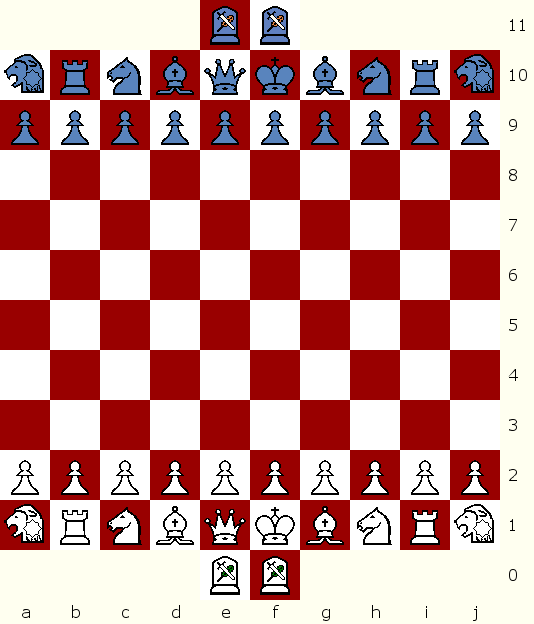 |
Start Position for white. (black mirrors white)
Insane Ninjas on a1,j1 Rooks on b1,i1 knights on c1,h1 bishops on d1, g1 queen on e1 king on f1 leaping ninja guards on e0,f0 pawns from a2-j2 |
The Pieces
The Mad Leaping Ninja Guard
The Leaping Ninja Guard is a color bound piece with three modes of movement and two capture modes.-
Movement:
- Move one step diagonally
- Leap two steps diagonally
- Leap an extended knight's leap i.e. three horizontal/vertical and one square perpendicular (3,1 leap).
-
Capturing
- It can capture on any square it lands just like a normal chess piece
- Capture by jumping over an enemy piece that is diagonally adjacent to it.
Note: that it can only do this type of capture when carrying out the 2 square diagonal leaping movement. - It can combine both capture modes to capture two pieces, the first immediately adjacent to it, and the next right after, in its path on a diagonal by jumping over the first one and capturing the second piece on the square it lands.
Note that the leaping ninja guard can only capture one piece on the square it lands if performing the extended knight 3,1 jump move or if moving one step diagonally.
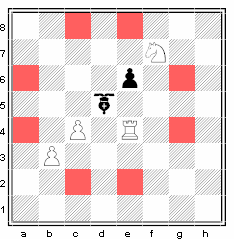 |
The Ninja Guard on d5 can capture all the pieces in the diagram. It can also jump to the squares in red, or
move to any square that is 1 step away diagonally that is not occupied by a friendly piece.
It can capture the pawn on c4 by moving to that square or capture both pawns on c4 and b3 by jumping to b3. It can capture the knight on f7 by jumping over the pawn at e6. It can capture the rook at e4 by moving to e4 or leaping to f3. |
The Insane Ninja
The Insane Ninja possesses both dual mode movement and dual mode capture capabilities.-
Movement:
- move one step in any direction (diagonally or orthogonally)
- Leap two steps in any direction (diagonally or orthogonally).
-
Capturing
- It can capture on any square it lands as normal pieces do.
- It can capturing any adjacent piece (orthogonally or diagonally) by jumping over it.
- Combine both capturing modes to capture two pieces (the first immediately adjacent to it, and the next right after) on any orthogonal or diagonal line by jumping over the first one and the capturing the second piece on the square it lands.
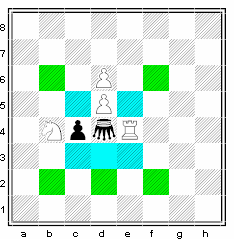 |
The Insane Ninja on d4 can capture all the pieces in the diagram.
It can also move to the squares in blue or the squares in green by leaping.
It can capture the pawn on d5 by moving to that square or capture both pawns on d5 and d6 by jumping to d6. It can capture the knight on b4 by jumping over the pawn at c4. It can capture the rook at e4 by moving to e4 or leaping to f4. |
Rules
The rules are as in orthodox chess except as noted below:-
Castling:
Unlike standard Chess, castling is flexible with the king able to travel 1, 2, 3, or 4 squares towards the rook.
There are 7 possible castling positions, the most extreme wing castling involves the king relocating to the b or i file. The choice of castling positions will depend on whether it is immediately necessary for the king to be tucked away at the wing or for the rook to be centralized.
The usual castling criteria apply: No piece can occupy the spaces travelled by the king and castling rook. Cannot castle out of check. King cannot pass over or land on squares attacked by enemy, but rook can.-
1 space transposition - King Side Castling
White moves King one space from f1-g1 and rook from i1-f1
Black moves King one space from f10-g10 and rook from i10-f10 -
1 space transposition - Queen Side Castling
White moves King one space from f1-e1 and rook from b1-f1
Black moves King one space from f10-e10 and rook from b10-f10 -
2 space transposition - King Side Castling
White moves King two spaces from f1-h1 and rook from i1-g1
Black moves King two spaces from f10-h10 and rook from i10-g10 -
2 space transposition - Queen Side Castling
White moves King two spaces from f1-d1 and rook from b1-e1
Black moves King two spaces from f10-d10 and rook from b10-e10 -
3 space transposition - King Side Castling
White moves King three spaces from f1-i1 and rook from i1-h1
Black moves King three spaces from f10-i10 and rook from i10-h10 -
3 space transposition - Queen Side Castling
White moves King three spaces from f1-c1 and rook from b1-d1
Black moves King three spaces from f10-c10 and rook from b10-d10 -
4 space transposition - Queen Side Castling
White moves King four spaces from f1-b1 and rook from b1-c1
Black moves King four spaces from f10-b10 and rook from b10-c10
Any other piece can occupy j1, j10, a10 or a1 during castling. -
1 space transposition - King Side Castling
-
Pawn Movement ():
The pawn can move from its original position either 1, 2 or 3 vacant squares forward.
A pawn, which initially moved forward 1 square or captured from its starting position, can subsequently at any time move forward 1 or 2 vacant squares. Once it reaches the center of the board (rank 5 for white, rank 6 for black), it can move forward only one square at a time.
Some examples: the white pawn at f2 can start f2-f5 or it can move f2-f4 then f4-f5, or f2-f3 followed by f3-f5, or move f2-g3 to capture enemy piece at g3 followed by g3-g5 next time it moves. - En Passant: If a Pawn moves two or three squares initially and passes an enemy Pawn on the
4th or 5th rank, it may be captured en passant by the enemy pawn.
E.g. White pawn on a2 black pawn on b4. White pawn moves a2 - a4 (or a5), black pawn on b4 can capture it as if it had moved to a3.
Similarly, black pawn on b5 and white pawn moves a2 - a5, then black pawn can capture the white pawn as if it moved to a4. Note in this case the white pawn can still avoid the black pawn by moving to a3 instead.
If a pawn slides forward 2 squares on its second move, it can also be captured en passant by an opposing pawn on the fifth rank. E.g. white pawn on a3 and black pawn on b5. White plays a3-a5, black pawn on b5 can capture the pawn en passant by moving to a4.
Capturing en passant is optional unless it is the only legal move available. The capture must be made on the next move. - Pawn promotion: Pawns must promote to: queen, bishop, knight, rook, leaping ninja guard or insane ninja on the 10th rank (Rank 10 for White, 1 for black).
- Optional Rule: Ninja Pawn drops: Ninja pawns can be dropped as described below
The Ninja Pawn

 The ninja pawn possesses slightly different modes of movement and capture depending on which half of the board it is on.
The ninja pawn possesses slightly different modes of movement and capture depending on which half of the board it is on.
Movement:
The ninja pawn can always move 1 square up or 1 square sideways to an empty square regardless of where it is situated on the board.
From the middle exactly, (rank 5 for white, rank 6 for black), the ninja pawn can move only 1 square forward, but thereafter as soon as it enters enemy territory (the upper half of the board: White rank 6-10, and for black rank 5 - 1), the pawn can go forward either 1 OR 2 empty spaces
Capture:
Like the standard pawn it can capture one square diagonally up, regardless of which half of the board it is on.
When the ninja pawn is on the top half of board (White rank 6 +, Black rank 5-) , it can also capture one square horizontally.
There is no en passant. It cannot capture another pawn or ninja pawn en passant nor can any other pawn capture it this way.
Promotion: The ninja pawn promotes on the last row (rank 10 for white, rank 1 for black), to any piece. Promotion to a piece is mandatory so it would cease to be a pawn in the last row.
Dropping:
The ninja pawn is not present at the start at the game and is dropped by the player into the drop zone, which are the 2nd row squares (row 9 for black, 2 for white). For example, the drop zone for white is a2-j2 and for black a9-j9.
The square must be vacant to drop the pawn. You can drop a pawn to check or to checkmate the opposing king
A maximum of 4 ninja pawns (1 per turn) can be dropped by each side during a game.
After dropping a pawn, the player can optionally move the ninja pawn forward 1 or multiple squares towards the center on the same move.
A capture or a side move is not permitted during the drop, so the player can just drop a pawn, or drop a pawn and move it 1-3 vacant squares towards the center.
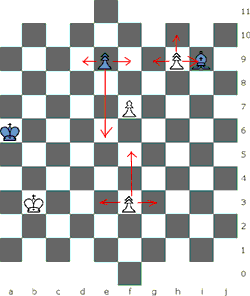 |
In diagram, the black ninja pawn can go from e9-e6 or any other square in between or d9 or f9. The white pawn at f7 cannot capture it en passant Lets say the white ninja pawn went from e3-f3 , it still has the option of shooting forward to the middle (f5) regardless of how many moves it made before. e.g. it can go e2-e3, then e3-f3 . It can now (see diagram) go f3-f5 if unobstructed.The white ninja pawn at h9 can capture the bishop at i9 in addition to being able to go to g9 or to promote by going to h10. |
Interesting points:
- The original start position has very similar weak points as the 8x8 standard chess game. For example the pawns g2 or g9 are protected only by their respective kings.
- The center pawns free the bishops just like in standard chess. And, instead of the knights, the leaping ninja guards attack the center pawns. For example, f2-f5 f9-f6 white can play f0-g3 . Later white can play g1-c5 striking at black's weak point.
- The insane ninja is very powerful especially in the endgame and it can easily checkmate the enemy king with the aid of its king.
In contrast, while the leaping ninja guard can be quite powerful in the opening and middle stages of the game, it cannot force the checkmate of the opposite king with the aid of its king. - The insane ninja may be worth slightly more than the rook, while the leaping ninja guard probably ranges from a little less to a little more than the power of the bishop.
Insane Ninja Chess 2
Insane Ninja Chess also introduces a 2nd Game, a sub-variant, which features the same pair of insane ninjas,
and a pair of ninja guards.
Ninja Guards are identical to the Mad Leaping ninja guards except for the absence of the long leaping move.
Thus, the ninja guards now only control 8 squares and are roughly equal in power to the knights.
This game uses the same board, but the pieces are arranged slightly differently: see board setup #2 below.
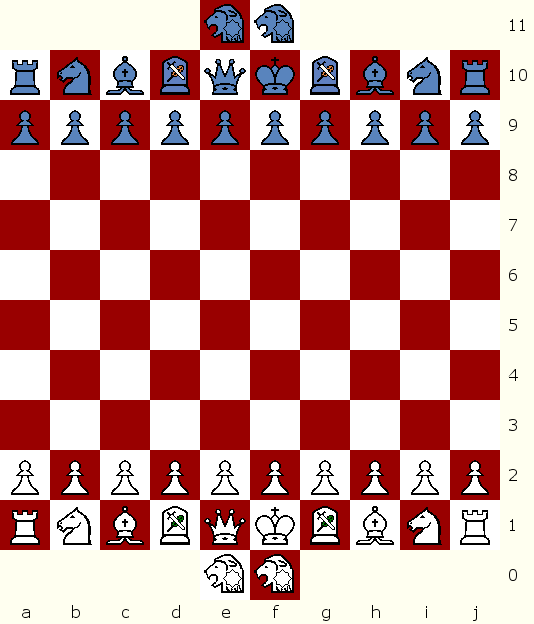
Play!
Play Insane Ninja Chess!Play Insane Ninja Chess 2
Free Registration requires at chessvariants.org
View Game Logs of Insane Ninja Chess The pieces in middle of the board (at ChessVariants) will clear once the preset is started.
|
If you would like to email the chess variant inventor directly: inventor@chess.computerwebservices.net
|
|
Posted by: insane on 2022-05-03 18:41:41 Like Chess: YES
Absolutely! |


